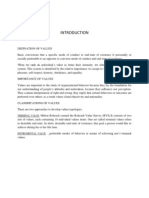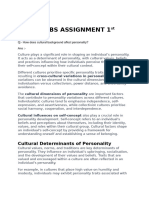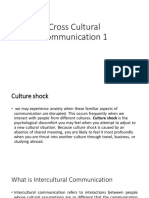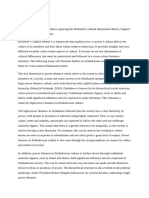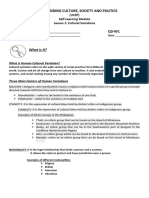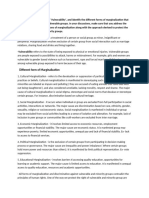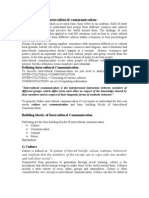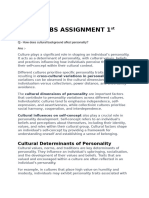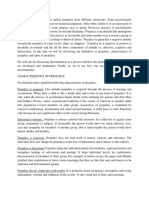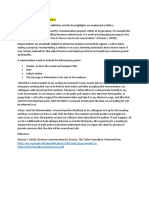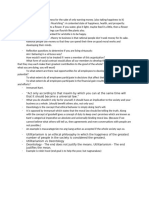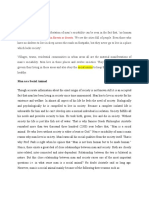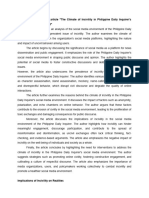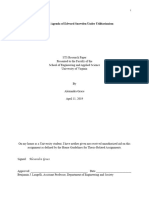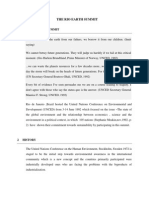BUS 1105 Discussion Forum Unit-7
BUS 1105 Discussion Forum Unit-7
Uploaded by
Su Myat NoeCopyright:
Available Formats
BUS 1105 Discussion Forum Unit-7
BUS 1105 Discussion Forum Unit-7
Uploaded by
Su Myat NoeCopyright
Available Formats
Share this document
Did you find this document useful?
Is this content inappropriate?
Copyright:
Available Formats
BUS 1105 Discussion Forum Unit-7
BUS 1105 Discussion Forum Unit-7
Uploaded by
Su Myat NoeCopyright:
Available Formats
BUS 1105 Discussion Forum Unit-7
Myanmar, a country in Southeast Asia, has a rich cultural heritage that is reflected in its societal norms
and values. In this essay, I will compare and contrast three cultural characteristics: collectivism,
uncertainty-accepting, and high-power distance, and describe how they apply to Myanmar's culture.
Collectivism vs Individualism:
Collectivism is a cultural characteristic that emphasizes group harmony, loyalty, and interdependence
over individual achievement and autonomy. In contrast, individualism focuses on personal goals, self-
reliance, and independence. Myanmar is a collectivistic society that places great value on social
harmony and family relationships. In Myanmar culture, families and communities are viewed as a source
of support and guidance, and individuals are expected to prioritize the needs of their group over their
own interests.
Uncertainty-accepting vs Uncertainty-rejecting:
Uncertainty-accepting cultures tend to tolerate ambiguity and unpredictability and are more
comfortable with risks and changes. Uncertainty-rejecting cultures, on the other hand, prefer structure,
rules, and stability. Myanmar is an uncertainty-accepting culture that values flexibility and adaptability.
In Myanmar society, people are accustomed to dealing with political and economic uncertainty and have
developed coping mechanisms to manage risk and change.
High Power Distance:
High power distance refers to a cultural characteristic that emphasizes hierarchy, authority, and social
status. In contrast, low power distance cultures tend to minimize social inequalities and encourage
participatory decision-making. Myanmar is a high power distance culture that values social hierarchy
and respect for authority figures. In Myanmar society, elders and senior officials are revered, and their
opinions and decisions are often unquestioned.
In comparison to my fellow peers, I find that Myanmar's cultural characteristics are similar to many
other Southeast Asian countries, such as Thailand and Vietnam, which also exhibit collectivism,
uncertainty-accepting, and high power distance. However, there are some variations in the degree to
which these characteristics are practiced, and these differences may reflect historical, religious, and
economic factors.
References:
Hofstede, G. (1980). Culture's consequences: International differences in work-related values. Beverly
Hills, CA: Sage.
Hofstede, G., & Bond, M. H. (1984). Hofstede's culture dimensions: An independent validation using
Rokeach's value survey. Journal of Cross-Cultural Psychology, 15(4), 417-433.
Triandis, H. C. (1995). Individualism and collectivism. Boulder, CO: Westview Press.
You might also like
- Heavy Gear Blitz Southern Field GuideDocument178 pagesHeavy Gear Blitz Southern Field Guidesaxon halflingNo ratings yet
- 35 Teenagers Teen DramaDocument4 pages35 Teenagers Teen DramaamhammondNo ratings yet
- Lion and The Jewel PDFDocument10 pagesLion and The Jewel PDFSain0% (1)
- Educ 107-Maam JarenDocument57 pagesEduc 107-Maam JarenMaribeth SebolinoNo ratings yet
- Questionb.: Define Culture What Are Culture DimensionsDocument18 pagesQuestionb.: Define Culture What Are Culture DimensionszeshanNo ratings yet
- SSG-Working in Diverse Team-Activity 02-Deadline 19.02.2023Document1 pageSSG-Working in Diverse Team-Activity 02-Deadline 19.02.2023midnightwally2003No ratings yet
- UCSP Reading MaterialDocument34 pagesUCSP Reading MaterialfrancisassisimontoNo ratings yet
- Hofsted QTKDQTDocument6 pagesHofsted QTKDQTThu Trang TrầnNo ratings yet
- Geert HofstedeDocument2 pagesGeert HofstedeEshiebel OrganistaNo ratings yet
- Cultural Value OrientationsDocument11 pagesCultural Value OrientationsmashamhmNo ratings yet
- MIDTERM LESSON For Multicultural Diversity in WorkplaceDocument8 pagesMIDTERM LESSON For Multicultural Diversity in WorkplaceAlaiza Maureen B. DalugduganNo ratings yet
- Defination of ValuesDocument11 pagesDefination of ValuesDipannita GhoshNo ratings yet
- BMT-Hofstede S Cultural DimensionsDocument6 pagesBMT-Hofstede S Cultural DimensionsadhityakinnoNo ratings yet
- Hofstede's Five Dimensions of CultureDocument3 pagesHofstede's Five Dimensions of CultureArfa Iftikhar100% (1)
- SEC PresentationDocument14 pagesSEC PresentationChandan rajNo ratings yet
- Adapting Communication To Cultures and Social CommunitiesDocument14 pagesAdapting Communication To Cultures and Social CommunitiesCINDY BALANONNo ratings yet
- Chapter 4-1Document15 pagesChapter 4-1nooralsakkaf2000No ratings yet
- Hofstede Cultural Dimension 1Document18 pagesHofstede Cultural Dimension 1Rias Wita SuryaniNo ratings yet
- USELF111Document8 pagesUSELF111Ai AhlamNo ratings yet
- PPTDocument21 pagesPPTnikhils88No ratings yet
- BS AssignmentDocument3 pagesBS Assignmentsonex sumanNo ratings yet
- Presentation On Gross Culture Cultural Communication Non Verbal CommunicationDocument34 pagesPresentation On Gross Culture Cultural Communication Non Verbal CommunicationAli AhmadNo ratings yet
- So For The Next TopicDocument7 pagesSo For The Next TopicChristine Marie RamirezNo ratings yet
- SM PptsDocument17 pagesSM PptsRicha GargNo ratings yet
- Cross Cultural Communication 1Document28 pagesCross Cultural Communication 1Nomi AlviNo ratings yet
- Lecture One Definition of TermsDocument4 pagesLecture One Definition of Termssamuel chegeNo ratings yet
- Cross Cultural Management in Globalized ContextDocument4 pagesCross Cultural Management in Globalized ContextMialy RabemanantsoaNo ratings yet
- Tracking The Trend of Freedom and Restriction On Women: Hofstede's Cultural TaxonomyDocument31 pagesTracking The Trend of Freedom and Restriction On Women: Hofstede's Cultural TaxonomyAyesha IqraNo ratings yet
- ThameDocument6 pagesThamemmelimoyo1No ratings yet
- Chapter 2.1 - CMN 201Document12 pagesChapter 2.1 - CMN 201MerajNo ratings yet
- Shalom H. Schwartz's FrameworkDocument18 pagesShalom H. Schwartz's Frameworkmarika sivovaNo ratings yet
- UCSP Week 1 6Document44 pagesUCSP Week 1 6Eunice GarciaNo ratings yet
- Ib GW Group5Document18 pagesIb GW Group5Sathish Kumar BNo ratings yet
- Hofstede's Cultural DimensionsDocument17 pagesHofstede's Cultural DimensionsAnand MauryaNo ratings yet
- Class 3 ValuesDocument14 pagesClass 3 ValuesFitha FathimaNo ratings yet
- DIVERSITY OF LEARNERS WITH AR Reaction Paper #2-ROMMEL OBILLODocument2 pagesDIVERSITY OF LEARNERS WITH AR Reaction Paper #2-ROMMEL OBILLORommel ObilloNo ratings yet
- UntitledDocument38 pagesUntitledRenadNo ratings yet
- Unesco - Eolss Sample Chapters: Cultural RelativismDocument6 pagesUnesco - Eolss Sample Chapters: Cultural Relativismsadafshahbaz7777No ratings yet
- Jak Narody Porozumiewają Się Ze Sobą W Komunikacji Międzykulturowej I Komunikowaniu MedialnymDocument18 pagesJak Narody Porozumiewają Się Ze Sobą W Komunikacji Międzykulturowej I Komunikowaniu MedialnymAarav AroraNo ratings yet
- Dimensions of Culture Lecture 2Document18 pagesDimensions of Culture Lecture 2boumalachahinez09No ratings yet
- Sociology NotesDocument18 pagesSociology NotesTabish HamidNo ratings yet
- Eso 14 em PDFDocument5 pagesEso 14 em PDFFirdosh KhanNo ratings yet
- Ucsp Week3Document2 pagesUcsp Week3Yueru RanNo ratings yet
- Culture in Dff3renceDocument6 pagesCulture in Dff3renceLester MojadoNo ratings yet
- Ucsp 1st WeekDocument6 pagesUcsp 1st WeekLiam FloresNo ratings yet
- Assignment: Government College University FaisalabadDocument11 pagesAssignment: Government College University FaisalabadNiaz HussainNo ratings yet
- Hofstede's Cultural DimensionsDocument3 pagesHofstede's Cultural DimensionsChandrani ChatterjeeNo ratings yet
- Discuss ‘MarginDocument11 pagesDiscuss ‘Margindevlock234No ratings yet
- UCSP ReviewerDocument5 pagesUCSP ReviewerHarley Ulysses Dapiaoen EchiverriNo ratings yet
- G. Hofstede Culture Dimensions: Assignment - 1Document3 pagesG. Hofstede Culture Dimensions: Assignment - 1pandalocalNo ratings yet
- Intercultural CommunicationDocument11 pagesIntercultural Communicationsafibba92% (26)
- Business Ethics 2 BBADocument19 pagesBusiness Ethics 2 BBAreeyaroymarryNo ratings yet
- BS AssignmentDocument2 pagesBS Assignmentsonex sumanNo ratings yet
- Elements+of+Culture Week+2Document3 pagesElements+of+Culture Week+2yungliangNo ratings yet
- International Organisational BehaviourDocument9 pagesInternational Organisational Behaviourarjun SinghNo ratings yet
- Using Examples, Discuss and Compare Any Two Cross Cultural ModelsDocument15 pagesUsing Examples, Discuss and Compare Any Two Cross Cultural Modelsconcerned studentNo ratings yet
- Prejudice PDFDocument6 pagesPrejudice PDFMahima100% (1)
- TTP ReportDocument26 pagesTTP ReportJovelyn Tanda ToledoNo ratings yet
- Cultural and Values Orientations - FinalDocument15 pagesCultural and Values Orientations - FinalanabelNo ratings yet
- SOC SCI 2nd WeekDocument13 pagesSOC SCI 2nd Weekfaqihafajar43No ratings yet
- UCSP ReviewerDocument3 pagesUCSP ReviewerpobleteczairaNo ratings yet
- Cultural and Values Orientations - FinalDocument15 pagesCultural and Values Orientations - FinalanabelNo ratings yet
- LJ Unit 4Document1 pageLJ Unit 4Su Myat NoeNo ratings yet
- BUS 1105 Discussion Forum Unit-2Document1 pageBUS 1105 Discussion Forum Unit-2Su Myat NoeNo ratings yet
- BUS 1105 Discussion Forum Unit-4Document1 pageBUS 1105 Discussion Forum Unit-4Su Myat NoeNo ratings yet
- BUS 1105 Discussion Forum Unit-5Document1 pageBUS 1105 Discussion Forum Unit-5Su Myat NoeNo ratings yet
- BUS 1105 Discussion Forum Unit-3Document1 pageBUS 1105 Discussion Forum Unit-3Su Myat NoeNo ratings yet
- ROL For ICSSR ProjectDocument2 pagesROL For ICSSR ProjectTruptant Amit KapadnisNo ratings yet
- RichardDocument2 pagesRichardEden Leysam PulmonNo ratings yet
- Assignment 8420Document57 pagesAssignment 8420Hajra iftiNo ratings yet
- History of The Afrikaans LanguageDocument10 pagesHistory of The Afrikaans LanguagevladislavayablonskaNo ratings yet
- Table On Comparison of TheoriesDocument2 pagesTable On Comparison of TheoriesAibiike Zakirova100% (1)
- P-Law As An Instrument of Social Change-India ContextDocument6 pagesP-Law As An Instrument of Social Change-India ContextAnklesh08100% (1)
- Literary Analysis of FilmDocument4 pagesLiterary Analysis of FilmTanya KirdyashkinaNo ratings yet
- Asha Result 12 JUN 2024Document8 pagesAsha Result 12 JUN 2024sangitabiswakarma85No ratings yet
- Valerio E. Kalaw vs. Ma. Elena Fernandez (G.R. No. 166357, 14 January 2015)Document27 pagesValerio E. Kalaw vs. Ma. Elena Fernandez (G.R. No. 166357, 14 January 2015)Ruiz Arenas AgacitaNo ratings yet
- People Do Not Do Business For The Sake of Only Earning MoneyDocument1 pagePeople Do Not Do Business For The Sake of Only Earning Moneyaleksiyaah lexleyNo ratings yet
- Sociability of ManDocument4 pagesSociability of Mananzala noorNo ratings yet
- Critical Summary of The ArticleDocument3 pagesCritical Summary of The ArticleEdsel AlapagNo ratings yet
- Introduction Philosophy 2ND Quarter ExamDocument10 pagesIntroduction Philosophy 2ND Quarter ExamEva Fe Vafz Mojado100% (1)
- Purp Comm Personal Informative DraftDocument9 pagesPurp Comm Personal Informative DraftAivanne Dela VegaNo ratings yet
- Alan StorkeyDocument2 pagesAlan StorkeyAbsalonMartinezNo ratings yet
- Grace Alexandra STS Research PaperDocument18 pagesGrace Alexandra STS Research Paperanirbansingha345No ratings yet
- 1e - Long Essay PromptsDocument2 pages1e - Long Essay PromptsjM mNo ratings yet
- Civil SocietyDocument36 pagesCivil SocietyMARC DANIEL CALUBNo ratings yet
- Rio Earth SummitDocument14 pagesRio Earth SummitmanavipathuriNo ratings yet
- Culture and GlobalizationDocument9 pagesCulture and GlobalizationPavuluri SairamNo ratings yet
- Moroccan Culture Prof BennisDocument2 pagesMoroccan Culture Prof BennisyoussefNo ratings yet
- Karl Marx and Communist Manifesto (1848)Document7 pagesKarl Marx and Communist Manifesto (1848)yourownkashmirNo ratings yet
- Clara BartonDocument12 pagesClara BartonCarlos SilvaNo ratings yet
- Lecture 2. Social ServiceDocument37 pagesLecture 2. Social ServiceRais AliNo ratings yet
- Angela Tharp PaperDocument6 pagesAngela Tharp PaperGeovanny Ramirez GiraldoNo ratings yet
- Unit-I MCQsDocument5 pagesUnit-I MCQssatishNo ratings yet
- Unit 1 - Reading N ListeningDocument6 pagesUnit 1 - Reading N ListeningtnhslzaloNo ratings yet











